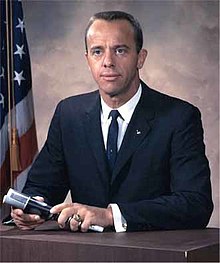Freedom 7

Still frame of Alan Shepard taken by a motion picture camera aboard Freedom 7
|
|
| Mission type | Test flight |
|---|---|
| Operator | NASA |
| Mission duration | 15 minutes, 28 seconds |
| Range | 487.3 kilometers (263.1 nautical miles) |
| Apogee | 187.50 kilometers (101.24 nautical miles) |
| Spacecraft properties | |
| Spacecraft | Mercury No.7 |
| Manufacturer | McDonnell Aircraft |
| Launch mass | 1,830 kilograms (4,040 lb) |
| Landing mass | 1,051 kilograms (2,316 lb) |
| Crew | |
| Crew size | 1 |
| Members | Alan Shepard |
| Callsign | Freedom 7 |
| Start of mission | |
| Launch date | May 5, 1961, 14:34:13 UTC |
| Rocket | Redstone MRLV MR-7 |
| Launch site | Cape Canaveral LC-5 |
| End of mission | |
| Recovered by | USS Lake Champlain |
| Landing date | May 5, 1961, 14:49:35 UTC |
| Landing site | North Atlantic Ocean 27°14′N 75°53′W / 27.23°N 75.88°W |
|
 Alan Bartlett Shepard, Jr.
Project Mercury
Manned missions |
|

Spacecraft name as painted on the capsule side
Mercury-Redstone 3, or Freedom 7, was the first United States human spaceflight, on May 5, 1961, piloted by astronaut Alan Shepard. It was the first manned flight of Project Mercury, the objective of which was to put an astronaut into orbit around the Earth and return him safely. Shepard's mission was a 15-minute suborbital flight with the primary objective of demonstrating his ability to withstand the high g forces of launch and atmospheric re-entry.
Shepard named his space capsule Freedom 7, setting a precedent for the remaining six Mercury astronauts naming their spacecraft. The number 7 was included in all the manned Mercury spacecraft names to honor NASA's first group of seven astronauts. His spacecraft reached an altitude of 101.2 nautical miles (187.5 kilometers) and traveled a downrange distance of 263.1 nautical miles (487.3 kilometers). It was the fourth Mercury flight launched with the Mercury-Redstone Launch Vehicle, from Cape Canaveral, Florida, close to the Atlantic Ocean.
During the flight, Shepard observed the Earth and tested the capsule's attitude control system, turning the capsule around to face its blunt heat shield forward for atmospheric re-entry. He also tested the retrorockets which would return later missions from orbit, though the capsule did not have enough energy to remain in orbit. After re-entry, the capsule landed by parachute on the North Atlantic Ocean off the Bahamas. Shepard and the capsule were picked up by helicopter and brought to an aircraft carrier.
...
Wikipedia
